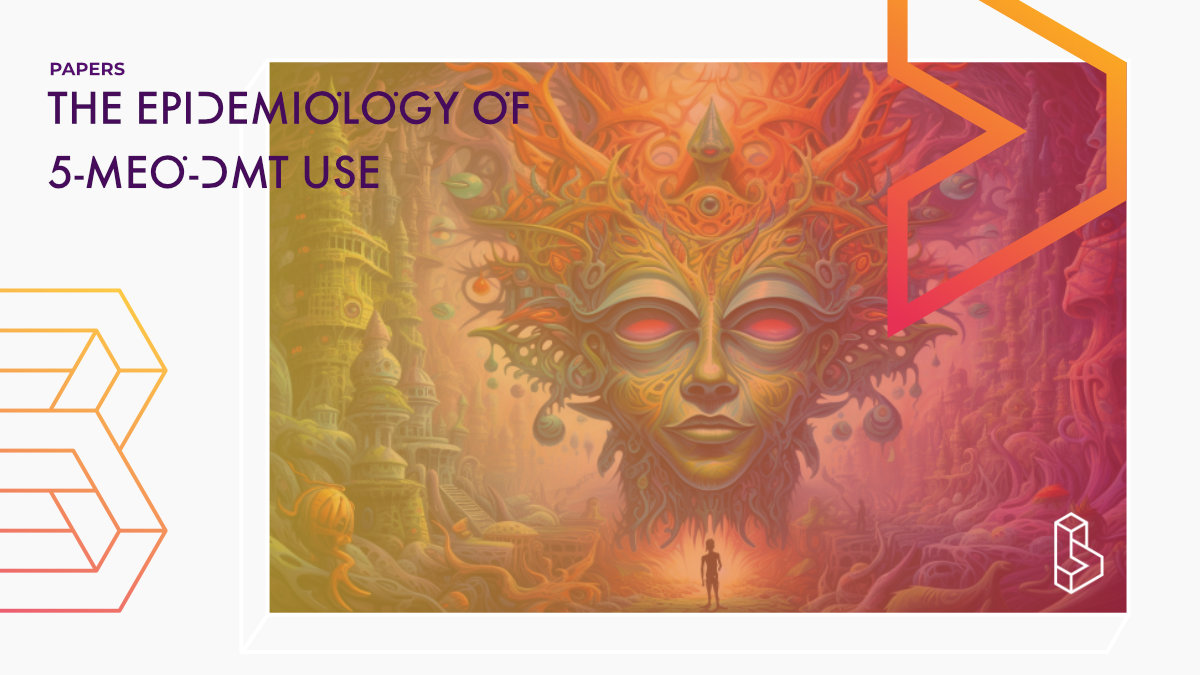This first epidemiological survey study (n=515) found that 5-MeO-DMT was used infrequently (<1x p/y) and mostly for spiritual exploration.
Abstract of The epidemiology of 5-MeO-DMT use
“Background/aim: 5-Methoxy-N,N-dimethyltryptamine (5-MeO-DMT) is a psychoactive compound found in several plants and in high concentrations in Bufo alvarius toad venom. Synthetic, toad, and plant-sourced 5-MeO-DMT are used for spiritual and recreational purposes and may have psychotherapeutic effects. However, the use of 5-MeO-DMT is not well understood. Therefore, we examined patterns of use, motivations for consumption, subjective effects, and potential benefits and consequences associated with 5-MeO-DMT use.
Methods: Using internet-based advertisements, 515 respondents (Mage=35.4. SD=11.7; male=79%; White/Caucasian=86%; United States resident=42%) completed a web-based survey.
Results: Most respondents consumed 5-MeO-DMT infrequently (<once/year), for spiritual exploration, and had used less than four times in their lifetime. The majority (average of 90%) reported moderate-to-strong mystical-type experiences (Mintensity=3.64, SD=1.11; range 0–5; e.g., ineffability, timelessness, awe/amazement, experience of pure being/awareness), and relatively fewer (average of 37%) experienced very slight challenging experiences (Mintensity=0.95, SD=0.91; range 0–5; e.g., anxiousness, fear). Less than half (39%) reported repeated consumption during the same session, and very few reported drug craving/desire (8%), or legal (1%), medical (1%), or psychiatric (1%) problems related to use. Furthermore, of those who reported being diagnosed with psychiatric disorders, the majority reported improvements in symptoms following 5-MeO-DMT use, including improvements related to post-traumatic stress disorder (79%), depression (77%), anxiety (69%), and alcoholism (66%) or drug use disorder (60%).
Conclusion: Findings suggest that 5-MeO-DMT is used infrequently, predominantly for spiritual exploration, has low potential for addiction, and might have psychotherapeutic effects. Future research should examine the safety and pharmacokinetics of 5-MeO-DMT administration in humans using rigorous experimental designs.”
Authors: Alan K. Davis, Joseph P. Barsuglia, Rafael Lancelotta, Robert M. Grant & Elise Renn
Notes on The epidemiology of 5-MeO-DMT use
This study (2018) identified how people (internet survey) used 5-MeO-DMT. It offers insights into the reasons they use it and the relative infrequency of use. The psychotherapeutic effects are not explored here by can be found described (favourably) in Davis et al. (2019).
Summary of The epidemiology of 5-MeO-DMT use
5-MeO-DMT is a natural psychoactive indolealkylamine substance found in Bufo alvarius toad venom and a number of plants and shrubs. It was first synthesized in 1936 and may have been used by indigenous cultures dating back to pre-Columbian times.
Despite anecdotal reports on the Internet, prevalence and use characteristics of 5-MeO-DMT are largely unknown because this specific substance is not included in most national epidemiological surveys. Additionally, estimates of the global prevalence of 5-MeO-DMT use are limited by lack of inclusion in epidemiological surveys.
Find this paper
https://doi.org/10.1177/0269881118769063
Paywall | Google Scholar | Backup | 🕊
Cite this paper (APA)
Davis, A. K., Barsuglia, J. P., Lancelotta, R., Grant, R. M., & Renn, E. (2018). The epidemiology of 5-methoxy-N, N-dimethyltryptamine (5-MeO-DMT) use: Benefits, consequences, patterns of use, subjective effects, and reasons for consumption. Journal of Psychopharmacology, 32(7), 779-792.
Study details
Compounds studied
5-MeO-DMT
Topics studied
Healthy Subjects
Study characteristics
Survey
Participants
515
Humans
Linked Research Papers
Notable research papers that build on or are influenced by this paper
Reactivations after 5-methoxy-N,N-dimethyltryptamine use in naturalistic settings: An initial exploratory analysis of the phenomenon’s predictors and its emotional valenceThis survey study (n=513) finds that reactivations (flashbacks) are common (27-86%) with 5-MeO-DMT use. The reactivations were generally perceived as positive (73-86%), with only some (4-7%) reporting them as negative. The change of reactivations was higher for those using 5-MeO-DMT in a structured setting, female, and older at the time of first use.

